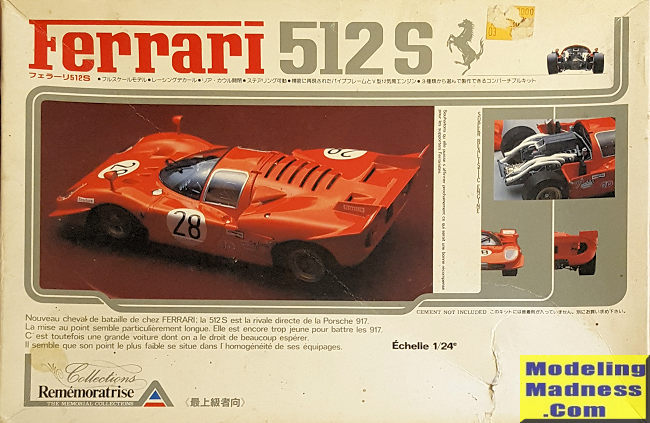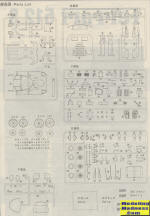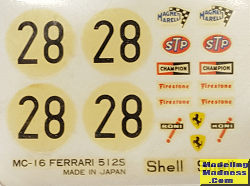
Union 1/24 Ferrari 512S
| KIT #: | MC 16 |
| PRICE: | I paid $7.00 at a swap meet |
| DECALS: | One option |
| REVIEWER: | Scott Van Aken |
| NOTES: | Reboxed Heller kit |

| HISTORY |
Until 1967, Ferrari raced four-litre prototypes, but due to the high speeds it achieved in Le Mans, also by the seven-litre V8 Ford GT40, the rules were changed for 1968 limiting Group 6 prototypes to a maximum engine capacity of three litres, as in Formula One. Despite having a suitable engine, Ferrari sat out the 1968 season, to return in 1969 with the Ferrari 312 P. In that year, Porsche had taken full advantage of a loop hole with the Porsche 917, making the risky investment of building 25 examples of a five-litre car to allow homologation into the FIA's Group 5 sports car category. Selling half of his business to Fiat, Enzo Ferrari raised the funds to match that investment. Surplus cars were intended to be sold to racing customers, which meant that several dozen high powered sports cars were available, and with each requiring two drivers in an endurance race, there was a shortage of experienced pilots.
The engine of the 512 S was a completely new 60° V12 with 560 PS (404 kW) output. Compared to Porsche's air-cooled flat-12, it needed a maze of cooling pipes and a heavy radiator. Since the chassis was of sturded steel, reinforced with aluminium sheet, weight was 100 kg more than that of the alloy-framed 917. Notwithstanding the weight difference and higher center of gravity, the Ferrari 512 S and Porsche 917 seemed fairly evenly matched.
At the beginning of 1970 the Ferrari 512s were hampered by predictable early problems, including a weak suspension and transmission problems, but the fact that Porsche already had six months of equally mixed experiences with its 917 in 1969 would be decisive for the rest of the season.
Contrary to Porsche, Ferrari did not organise an intramural competition. At Porsche, JWA Gulf, KG Porsche Salzburg and later Martini Racing, all received direct factory support. Thus, at least four cars were real works cars, without putting strain on the factory itself, as personnel and funds were provided by these professional teams. Even the privateers like AAW Shell Racing and David Piper Racing received much better support than Ferrari's clients. Ferrari did not adopt this modern scheme, but entered cars themselves in the traditional manner, as "Spa Ferrari SEFAC". Having only a few Formula One drivers under contract in the previous years, with the sports car aces driving for Porsche, Ferrari could barely find qualified drivers for its entries. Besides the factory cars, there were the private cars of Scuderia Filipinetti, NART, Écurie Francorchamps, Scuderia Picchio Rosso, Gelo Racing Team and Escuderia Montjuich. Those private cars never received the same support from the factory. They were considered as field fillers, never as candidates for a win.
At the end of the 1970 season, Ferrari had won the 12 hours of Sebring, while the Porsche 917 and 908 took the remaining nine wins of the championship season. At Le Mans, the Ferrari suffered from reliability problems, although it was considered to be equally fast to the 917. Four 512s were entered by Ferrari for that race, but the Vaccarella/Giunti car was out after seven laps, the Merzario/Regazzoni car was out after 38 laps and the Bell/Peterson car was out a lap later, and about five hours later the Ickx/Schetty car was out after 142 laps. For speed tracks such as Le Mans, Spa, Monza and the Osterrichring, an extra rear body panel designed to suit the 512 better was fitted on the car. The modified 512 M had proven to be fast at the end of the season, and Ickx/Giunti also won the Kyalami non-championship Springbok nine-hours race. As the loop hole for the five litre sports cars became obsolete after 1971, Ferrari decided to abandon factory entries of the 512 in favor of developing a new three litre prototype. In 1971, Penske entered an improved 512 M (No. 1040) in Sunoco livery which was able to challenge the 917, taking pole position several times.
| THE KIT |
 With
147 parts, most of them in white or grey plastic, this is not a simple kit. It
is not a new one either. If one believes Scalemates, this was initially released
by Heller in 1971 and has since been reboxed by Protar, Wave, Fujimi, and
Testors, to name at few. At one time I did have the Testors boxing. Apparently
Union released this one some time in the 1980s, though the instructions look
older than that.
With
147 parts, most of them in white or grey plastic, this is not a simple kit. It
is not a new one either. If one believes Scalemates, this was initially released
by Heller in 1971 and has since been reboxed by Protar, Wave, Fujimi, and
Testors, to name at few. At one time I did have the Testors boxing. Apparently
Union released this one some time in the 1980s, though the instructions look
older than that.
Anyway, this is not a curbside. There is full engine detail along with all the framework that is attached to the rear firewall to hold it and the rear suspension in place. Though the parts are remarkably clean, there will still be quite a bit of mold seam to clean up so be prepared to spend quality time with your hobby knife and sandpaper.
In regards to the engine, the instructions show you drilling holes for the engine wiring and attaching it to a magneto. the exhaust is also quite complex with six separate exhaust tubes per side, with three going into a collector and two piece exhaust, making for a total of 24 exhaust sections to get together.
You are also provided springs for the coil over shocks front and rear. It appears that you are able to build the front suspension so that the wheels turn and you should also be able to depress the suspension front and rear, assuming you don't break any of the somewhat small suspension attachment points.
All of the glass attaches from the outside so you have the
opportunity to paint the body bits before attaching any of them. There are no
colored lenses for the tail lights so clear red would be the paint of choice for
those.  The
tires are very nicely formed. When it comes to the final build, there are three
variations for the aerodynamic devices; a manufacture type, Le Mans type, and
Daytona type. You'll need to make that choice fairly early so you can have these
bits in place prior to painting.
The
tires are very nicely formed. When it comes to the final build, there are three
variations for the aerodynamic devices; a manufacture type, Le Mans type, and
Daytona type. You'll need to make that choice fairly early so you can have these
bits in place prior to painting.
Instructions are well drawn with most information in Japanese. The decal sheet is beyond its 'use by' date and is quite yellowed. However, Studio 27 makes several aftermarket sheets for the 512S, though none of them seem to be for the 28 car.
| CONCLUSIONS |
| REFERENCES |
https://en.wikipedia.org/wiki/Ferrari_512
August 2019 Copyright ModelingMadness.com. All rights reserved. If you would like your product reviewed fairly and fairly quickly, please contact the editor or see other details in the
Note to
Contributors. Back to the Main Page
Back to the Review
Index Page
Back to the Previews Index Page